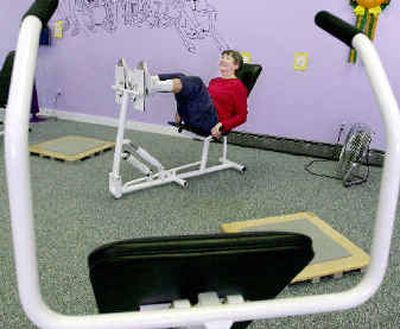Lean business model succeeds

HOLLIS, Maine — On a winding country road in the middle of nowhere, a building that once housed an antique shop now holds groups of women working out. Curves, a no-frills fitness club for women, can be found in the oddest places.
Targeting women in small-town America is part of the company’s business strategy — and it’s working. Curves has grown to more than 8,400 franchises in all 50 states and 28 countries, making it by far the world’s No. 1 fitness center in terms of number of clubs. One in every four fitness clubs in the United States is a Curves. There are 13 locations in the Spokane-Coeur d’Alene area.
In some ways, Curves is the anti-club: no treadmills, no saunas, no locker rooms, no mirrors, no aerobics classes, no free weights. Forget the spandex — sweat shirts rule.
Members work out on eight to 12 hydraulic resistance machines, stopping between stations to walk or jog in place. The clubs’ standard routine is over in 30 minutes and is designed to burn 500 calories.
While other clubs go after the prized 18-to-34 demographic, Curves’ customers are more likely to be aging baby boomers.
Sharon Morrison, owner of five Curves in Maine, including the one in Hollis, said there’s a comfort level and camaraderie at Curves that women can’t get elsewhere. At the same time, she said, they’re losing pounds and inches.
“I had joined so many clubs in my life, and all I had lost was money,” Morrison said.
The company is the creation of Gary Heavin, 49, who heads Curves International Inc. in Waco, Texas. Heavin was a millionaire by age 30 after taking over a failing health club in Houston and expanding it into a chain of 17 clubs. But then came a divorce, bankruptcy and business failure. He spent 2 1/2 months in jail when he couldn’t make child support payments.
In 1992, Heavin and his second wife, Diane, opened the first Curves club. It was small and simple, a place where women could feel comfortable.
Three years later, Heavin was selling franchises, and by 1998 there were 500. Curves aims to have more than 25,000 — including 8,000 in Asia and 8,000 in Europe — within five years. By comparison, Gold’s Gyms and Bally Total Fitness, two of the biggest fitness clubs in the country, have about 1,000 facilities between them.
“We’re the McDonald’s of fitness centers in America and Canada,” Heavin said. “And we can be the McDonald’s of fitness centers around the world.”
One reason for fast growth is the low cost. Club owners pay $29,900 for a franchise, equipment and training, plus a monthly franchise fee of $395. Club members usually pay $29 a month, far less than conventional fitness clubs.
The clubs are typically just 1,000 or 2,000 square feet or so, with few frills and low overhead and limited hours of operation. Compare that to the large multipurpose clubs, which can be 30,000 to 40,000 square feet with a full assortment of fancy machines, locker rooms and amenities.
It is that efficient business model that allows Curves to enter small markets. Rather than take customers away from other clubs, Curves creates its own markets and generates customers from where a customer base didn’t exist before.
Heavin is credited with shaking up the fitness center industry.
The Curves phenomenon has “forever altered the landscape of the worldwide fitness industry,” John McCarthy, executive director of the International Health, Racquet and Sportsclub Association, wrote in a recent state-of-the-industry letter to association members.